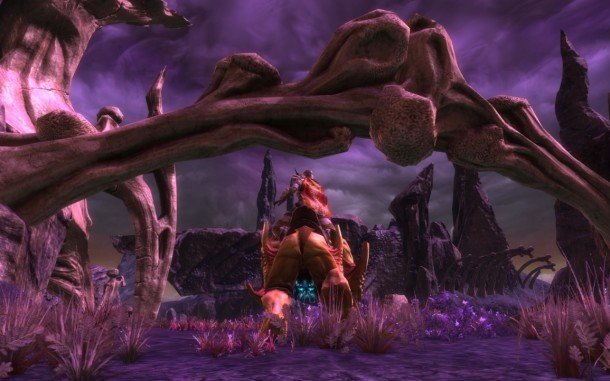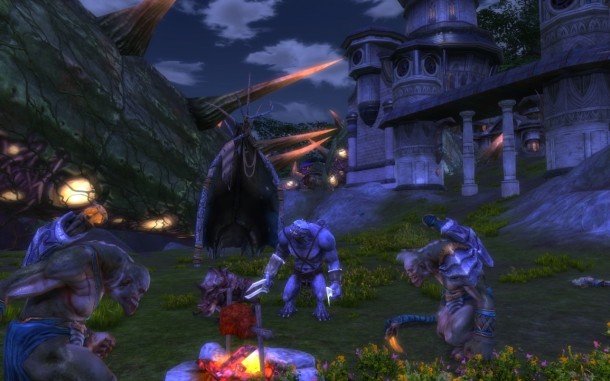Our Verdict
Storm Legion isn't the most innovative of expansions, but the vast amount of content added makes it practically essential for Rift fans.
PC Gamer's got your back
Blimey, it's big. Rift wasn't exactly slight to begin with. Set in the fantasy world of Telara, its vast continent was more than just a world to fill with quests. The titular rifts - tears in reality brought forth by the six elemental dragon-deities - were constantly haranguing the beleaguered player-faction, the Ascended. The result was a world that would dramatically shift around the efforts of the community. Left unchecked, these rifts spawned raiding parties of monsters, who'd assault strategic outposts to establish deadly footholds. It then provided regular and expansive post-launch updates, making it one of the few subscription MMOs that justified its monthly toll.
Storm Legion increases Rift's size dramatically. It isn't an expansion so much as it's a second Rift bolted onto the back of the game.
Two new continents have been added, each roughly the size of the original, to take level 50 players to the new cap of 60. But sheer acreage alone means little if there's nothing going on inside of that space. Fortunately, the new lands of Brevane and Dusken are filled with content. There are two new questlines, dungeons, raids, a PvP warfront and plenty of sidequests to discover.

That said, you're not going to find anything that shakes up the formula of the base game. Storm Legion's overriding adjective is “more,” not “different.” Take the new Carnage quests. They're Kill X Things quests, and there are loads of them.
It's hardly the most innovative idea, but, to damn with faint praise, they're one of the better implementations of dull quest churn. Automatically activating whenever you kill the relevant mob, they don't require collecting from a quest hub, so there's never any wasted kills. The downside is that it's blatant content padding; an easy and rather transparent method of keeping you busy.
While technically optional, Carnage quests are a significant percentage of the potential XP gain. Levelling in Storm Legion requires that you bounce between the two continents, questing through the lower level areas of both, before being able to move on to the higher levels of either. But story quests alone won't be enough to keep you competitive. That means either taking the extra time to hunt out and complete Carnage, or grinding out dailies and PvP to make up the shortfall.

A game-wide change does reduce the tedium of monster hunting quests. The 2.0 update that released alongside the expansion changes the way credit is awarded for kills. Now anyone involved in defeating a mob, be it through direct attack or healing assist, is given a share of the XP, and the kill counts toward their mission objective.
It's a clear nod to the way Guild Wars 2 handles questing, and it's a move that accentuates the shared experiences that should be at the heart of a massive online game. Playing Rift feels less like being part of a thousand separate single player campaigns running parallel. While some will take advantage of the system, one-hit tagging each mob to steal a share of XP, the positives far outweigh the actions of a few inevitable jerks.
Storm Legion seems to have been designed to focus on the ebb-and-flow of dynamic content. At one point, while attempting to clear my quest log before hopping over to the other continent, I instead spent hours closing rifts, attacking footholds, completing Instant Adventures and, yes, even finishing a Carnage quest or two. Rift's strength has always been the ability to offer you more than just quest hubs full of static exclamation marks, and here the vast majority of your time will be spent adventuring.

As well as each area being full of new enemies and higher level dynamic events, Storm Legion introduces Hunt rifts. They work like regular rifts, but in reverse: with players attempting to summon a planar commander while waves of enemies attack their position. Successfully defend the rift and the commander emerges, with specific lures allowing you to choose which one you fight. They're great fun and seriously tough. Where normal minor rifts can be easily tackled solo, even the simplest of Hunt rifts requires a few players working together.
With so much focus on dynamic content, the story acts as more of a throughline between each area – a forgettable diversion for all but the hardest of lore nuts. Dragon god Crucia has roused up her storm legion to assault the two continents, and sorting the mess out involves a whole lot of fetching, delivering, destroying, escorting and helplessly watching as villains enact their plans.
Far more noticeable is the world design. While the areas in each continent are less wildly variable than Rift's Mathosia, they contain much weirder landscapes and features. Dusken is huge and barren, with its four areas themed around death. It's the less striking of the two places, but the bone graveyard of Seratos makes for an impressive centrepiece. Brevane's life theme offers the opposite: a warren of ruined buildings overgrown with creepy red tentacle plants. Both are more interesting locations to explore than the rather standard fantasy offerings that Rift originally offered.

Thanks to the Storm Legion threat, Guardians and Defiants are now working together. Not only does this mean that both get to share Tempest Bay, the new island city hub, but also that grouping, dungeon running and guild registration are no longer faction specific. Players can now join up with anyone using the expansion, which helps reduce the time spent queueing.
Unless, that is, you're waiting for something specific. Rift only awards daily quest bonuses for joining random queues, and as such, that's what most players are doing. After over 35 hours of questing, my character had two of the new dungeons unlocked and, even in the launch week, the grouping system could spend hours looking for a party without ever finding a result.
The same is true of Warfronts, although the impact is much less. Finding games of Karthan Ridge, Storm Legions new battleground, takes longer than jumping in the random queue. But for me the enjoyment of Rift's PvP comes from the quick-fire bouts of action over the map objectives that cause them. The eponymous ridge makes for some nice dual-level combat, but it's an arena that fits nicely into the rotation rather than one I've gone out of my way to play.

Storm Legion has less to offer players who are yet to hit the level cap, but there are still some additions available worldwide. Dimensions are self-contained homes that you can teleport to at any time and, rather than simple static locations, they let you build and place down objects. The build mode is a relatively simple drag and drop affair, but assuming you've got the talent, it's possible to create extremely detailed structures and objects.
For me and other cack-handed laymen, what saves Dimensions from being ultimately pointless is the social features. A ranking system lets the community rate public Dimensions, allowing players to easily drop in to mooch about the towering structures and fiendish jumping puzzles that others have created. It's not likely to be something you'll spend loads of time investigating, but it's a nice diversion to have nonetheless.
Character classes have had an overhaul, with each getting a new soul to expand the potential roles they can occupy. The simplest additions are for the warrior and mage, who gain ranged and melee attacks respectively, increasing their effectiveness in situations they would traditionally be weak.
The rogue and cleric have more tactical shifts to their combat style. The cleric's Defiler soul is a healing-focused subclass that works by creating links between players and re-routing damage back to themselves. It's a tricky role to get the hang of, but should be ideal for masochistic doctors everywhere.

For versatility, however, the rogue's Tactician is the best of the new styles. With it you can throw down static cores that provide AoE buffs and use torrents of flames that can heal or deal crowd-control damage. It syncs nicely with the bard soul, essentially letting you role-play a folk-singer with a flamethrower.
While the sheer amount of things to do is Storm Legion's greatest strength, not all of it works. For example, the Secrets of the Deep Event in Seratos ends in a 434,247,104 HP endurance test through Nautilian, a world boss that does a whole lot of not much except take 40 minutes of idle key-tapping to kill. Or there's the Storm Breaker Protocol dungeon, that has you piloting a mech suit with limited abilities through endless processions of bugs.
But the occasional drop in quality is balanced by the strength and size of what does work. Storm Legion brute forces brilliance through the number of things available for players to experience. It increases the ways in which Rift can be Rift, making an already great game even better.
If you've yet to hit the level cap, you're best off waiting. The new souls provide some great variation in PvP and grouping, but they're not a dramatic enough change to justify buying the expansion. But if you've hit level 50 and want even more Rift to get stuck into, Storm Legion is exactly what you're looking for.
Storm Legion isn't the most innovative of expansions, but the vast amount of content added makes it practically essential for Rift fans.

Phil has been writing for PC Gamer for nearly a decade, starting out as a freelance writer covering everything from free games to MMOs. He eventually joined full-time as a news writer, before moving to the magazine to review immersive sims, RPGs and Hitman games. Now he leads PC Gamer's UK team, but still sometimes finds the time to write about his ongoing obsessions with Destiny 2, GTA Online and Apex Legends. When he's not levelling up battle passes, he's checking out the latest tactics game or dipping back into Guild Wars 2. He's largely responsible for the whole Tub Geralt thing, but still isn't sorry.


